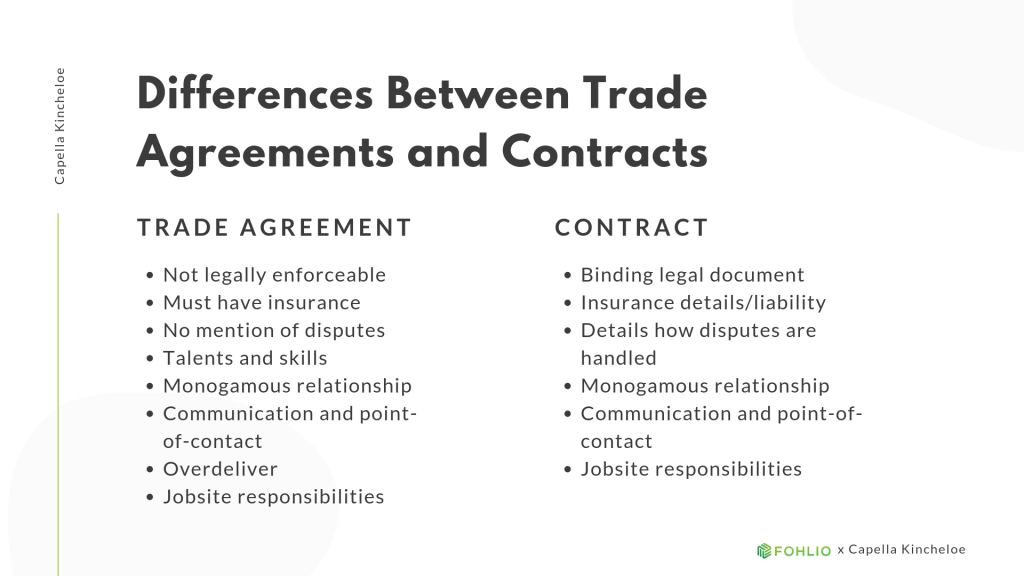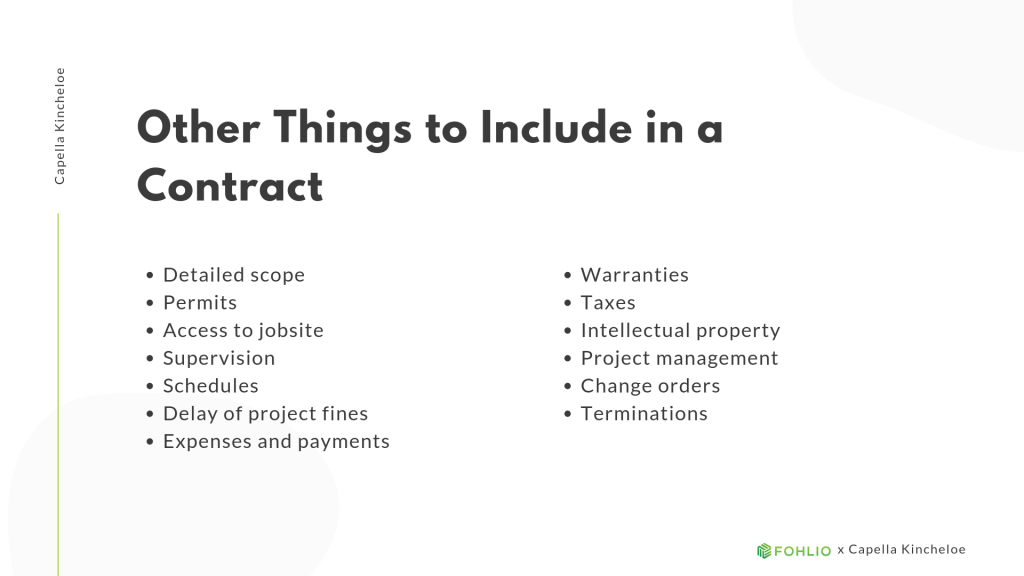
Manage FF&E specification, procurement, and product data at scale. Take on bigger projects with confidence and grow your firm with Fohlio. Book a consultation to explore these features today.
Interior design and construction projects are always collaborative, which is why it’s always crucial to have common rules and goals for everyone to follow. But how formal does your agreement have to be? And what’s a trade agreement as opposed to an interior design and/or construction contract, anyway? What should you include in either in order to make them enforceable?
The Differences Between Trade Agreements and Interior Design and/or Construction Contracts
A trade agreement is a sort of blanket agreement for trades working on a project. It can be used for small or large projects and generally is not going to change. It’s really just a simple document that sets your expectations for working together. Both designers and contractors can use this for working with other trades, subcontractors, or each other.
In my book, the trade agreement differs from the contract in that the contract spells out things in a lot more detail. It will contain things like insurance details, responsibilities, scope, payments, disputes, damages, et cetera. It’s very specific to the project.

A trade agreement, on the other hand, could be used for any project. While a contract is something that you would use more with a client, a trade agreement is closer to a formalized code of conduct. It will include expectations for working together on the project.
I think of the trade agreement as being more empowering to the people working on the project, so that you’re all on the same page and with the same understanding of what’s expected.
Of course, there’s nothing standardized about a trade agreement between contractors and designers. There’s not even a consensus on what the documents might be called. Some people may call a trade agreement a contract or vice versa, a contractor contract, contract agreement, construction contract, and more. It’s really up to you to decide what you want to call it, what to include in it, and what you want it to do for you.
You could have just a simple code of conduct which would read like a page out of an employee handbook, and formalize it with a trade agreement. Or, you could incorporate it all into one document if you’re the one doing the hiring and having to specify those responsibilities and scope in the contract. If you’re not doing the hiring though, a trade agreement is a nice bridge.
What to Include in Trade Agreements and Interior Design-Construction Contracts
Let’s look into what should be included in a trade agreement or contractor contract. Again, a lot of this depends on whether you’re hiring the other professional or not. There are some legalities involved that you would want to work out with an attorney. If you’re not doing the hiring, then the client would really be the one to have the contract with the contractor or designer directly.
To give you an idea of the tone of the trade agreement, here’s a starting paragraph:
It is Capella Kincheloe Interior Design’s ultimate ai for projects to go smoothly and efficiently. We want clients to be thrilled with the work of every person on the project. Together we can create amazing results for our clients. To satisfy the customer and minimize conflict we need to ensure we are working towards a common goal with shared expectations and standard goals.
For our working relationship to be mutually beneficial and proceed on schedule with minimal issues, we’ve created a framework to accomplish as described above.
What other differences are there between a trade agreement and an interior design-construction contract?

A trade agreement is probably not legally enforceable. When done properly, a contract should be binding.
A trade agreement would say something like, company and the clients require all trades to keep updated insurance and workman’s compensation. Proof of insurance may need to be provided to the client, designer, and the client’s insurance company. The contract would likely spell out exactly how much that insurance has to be, and it may even require adding another insurer to the policy.
In my trade agreement, I don’t mention how disputes are going to be handled, because it is about empowering people on the project. But in a contract, you would have to, and usually, this clause would have something about arbitration or where you would go to court.
In the trade agreement, I would also say that we respect the talents and skills of the trades, and that we want creative solutions. However, I would probably not say this in a contract, unless I was combining them both into a single document.
Something I would mention in both documents is that if I were the one bringing another professional onto a project, is that I would expect that professional to not accept work directly from the client.
Another topic that would be included in both documents is about communication and who the main point of contact is. This would answer the questions, who is the main project manager and who is the main client liaison.
My trade agreement has several points on communication. One says, “Good communication is the bedrock of a smooth project. Trades are encouraged to communicate early and often. We expect trades to be timely in their communications.” In the contract, it would probably go into a little bit more detail.
I also like to mention in my trade agreement that it’s better to under-promise and overdeliver, than overpromise and under-deliver. This is just a philosophy, which is why it would be included in my trade agreement but not in a contract.
Also like to go into jobsite responsibilities in both documents. This would include things like smoking, off-color humor and jokes, swearing, appropriate attire on the jobsite, and jobsite cleanliness.
There are some more things you would probably include in a contract that you wouldn’t mention in a trade agreement.

These things would include: detailed scope of work, who’s responsible for permitting, how to access the jobsite, what’s required for supervision on the jobsite, the exact dates and schedules, if there are any delay of project fines, how expensive payments are handled, warranties, taxes, intellectual property, project management, change orders, how the contract or working relationship would be terminated.
A lot of this would be specific to that particular job. With any legal document, you do want to consult an attorney for specific advice on your business and your local government.
Featured image by Donghyun Lim for the Washington Post Express
This post is an excerpt of a webinar and podcast by Capella Kincheloe, hosted by Fohlio Inc. You can watch the complete webinar with visual aids here, or listen to the complete podcast here:
Subscribe to our podcast here!
Fohlio makes collaboration easy with intelligent data sharing and a centralized data library. Find out how we can help you grow you grow your bottom-line – Book a consultation to explore these features today.

Expore Fohlio
Learn how to:
- Save days of work with faster specification
- Create firm-wide design standards
- Automate and centralize procurement
- Keep your whole team on the same Page
- Manage product data
- Track budget against cost in real time.
- Prepare for asset valuation
Published Apr 17, 2019

